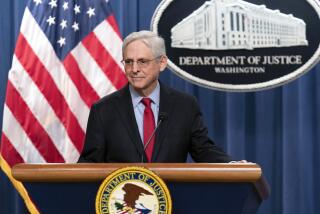Sun Suit Sheds Light on Microsoft’s Tactics
- Share via
“Subversion has always been our best tactic . . . subversion is almost invariably a better tactic than a frontal assault . . . it leaves the competition confused, they don’t know what to shoot at anymore . . . “
--John Ludwig, Microsoft vice president in charge of Java development
*
It was 4:45 a.m. on March 12, 1997. Following a grueling 18-hour negotiating session, the two bitter rivals had finally signed an agreement. Sun Microsystems would license its innovative Java technology to Microsoft. In exchange, Microsoft would use its massive market presence to help distribute the technology.
The deal was hailed as a major victory for Java. Overnight, the technology would become available on millions of desktops.
But within Sun, a lot of executives were skeptical.
“The planet is littered with companies that did deals with Microsoft expecting to win big but ended up getting screwed,” warned James Gosling, a Sun vice president and one of the original developers of Java, in an e-mail to Sun Chief Executive Scott McNealy.
Gosling, along with everyone else in the computer business, was well aware of the story of how Microsoft Chief Executive Bill Gates, a college dropout, had almost single-handedly out-negotiated a team of IBM lawyers to retain full rights to the PC software that set the standards for an industry.
Gosling’s warnings proved prescient. Within months the two companies were at loggerheads. Today Sun is engaged in a fierce lawsuit against Microsoft for allegedly violating its contract. And Microsoft’s alleged campaign to undercut Sun’s Java has become a featured component of the Justice Department’s antitrust case.
A decision by U.S. District Judge Ronald Whyte on Sun’s request for an injunction barring Microsoft from shipping its version of Java is expected as early as this week, with a trial to follow in the coming months. Microsoft insists it has done nothing illegal with respect to Java, and many legal experts are inclined to agree. But the documents Sun has received from Microsoft as part of the suit, many of which are only now being unsealed, provide rare insight into the bare-knuckled, shrewd and sometimes duplicitous tactics Microsoft deploys to defend and extend its Windows monopoly.
Although Java had been around for years, it wasn’t until 1995 that Sun began to position the programming language as the solution to software developers’ biggest headache: the need to rewrite their computer code for each of the computer systems in widespread use. According to Sun’s approach, each computer system would have a layer of software on it called a Java Virtual Machine that would allow it to run applications written in Java.
In public, Microsoft pooh-poohed the technology, but in private, Microsoft was quick to recognize Java as a threat.
“This hiding of the Microsoft [Windows] franchise is certainly not good for Microsoft,” argued a November 1995 Microsoft white paper.
Although Microsoft announced in December that it would support Java as part of its broader embrace of Internet standards, behind the scenes, according to a February 1996 memo by Microsoft executive Paul Maritz, the company was already taking steps to “neutralize Java.”
Sun’s first huge mistake was to underestimate Microsoft. Sun assumed Microsoft would merely exploit Sun’s Java code, and its legal agreement was designed to protect that code. Instead, taking advantage of its huge army of programmers, Microsoft wrote its own Java Virtual Machine from scratch. When Microsoft showed the program to Sun in May 1996, just two months after the agreement had been signed, Sun executives found it “scary” how much effort Microsoft was putting into Java.
Sun executives began to question the contract they had signed with Microsoft.
“Microsoft was smarter than us when we did the contract,” David Spenhoff, director of product marketing at Sun’s software arm, wrote in an e-mail. Spenhoff worried the contract limited Sun’s ability to make Microsoft adopt new additions to its Java standard.
Stopping Java a Top Priority
To build up its defenses, Sun, working closely with IBM and Netscape Communications, announced plans in May to develop Java Beans, a tool for developing Java-based applications that directly challenged Microsoft’s own approach to writing software. Microsoft, which wasn’t told about the announcement until the day before, was furious.
Sun launched another salvo aimed at Microsoft later in the year with a “100% pure Java” program designed to pressure Microsoft into following Sun’s lead.
As Java gathered industry support throughout 1996, Gates wrote e-mail in September expressing his concerns. “This scares the hell out of me,” Gates wrote, calling on Microsoft to make it a top priority to stop Java.
Initially, some Microsoft executives argued that the best approach was to do a better job than Sun at offering versions of Java that worked on multiple platforms. At a Feb. 7, 1997, meeting of Java developers, Microsoft executive Ben Slivka promised Microsoft would “proceed in a standard way, not do the cowboy thing.”
If that was the message Slivka carried to Gates, it didn’t get a welcome response. Says Slivka in an e-mail: “Bill is really pissed about this Java stuff . . . he just jumped all over me, accusing me of trying to destroy Windows.”
A month later, Slivka went back to Gates with a memo summarizing the key issue as “how do we wrest control of Java away from Sun.”
For that task, Microsoft turned to its developer division, which had close ties with hundreds of thousands of programmers around the world and had frequently been the company’s strategic weapon in standards battles.
Microsoft would develop Java tools that, once popular, would help get developers to write applications only for Microsoft’s virtual machine. The goal, according to one Microsoft report, was to “pollute” Java and “let Java . . . fragment, so that ‘write once, run anywhere’ does not happen.”
Explained Slivka in a deposition: “It would just confuse Java developers about which Java platform they should write for.”
Internally there were doubts about the strategy. “I believe that our true goal, controlling the future of Java, will be totally transparent and mostly unacceptable to all Java [developers],” Paul Gross, head of Microsoft’s tools division, said in an e-mail.
Nevertheless, Microsoft distributed 1.25 million copies of a free beta version of its Java programming tool and got 200,000 developers to use it.
It was a potent weapon. In a recent survey of corporate information managers, Zona Research found that while a majority of respondents believed Sun was the most influential in setting Java’s direction, a majority said that when it came to tools to develop Java applications, they would buy Microsoft products.
Another way Microsoft hoped to undercut Sun’s control over Java was to distribute its Java Virtual Machine so widely that it became the accepted standard for Windows. Once Microsoft’s JVM became the standard, Microsoft executives argued, developers would feel compelled to develop for Microsoft’s version, even if it were incompatible with Sun’s version.
Private, Public Words at Odds
While publicly, in the summer of 1997, Microsoft executives were arguing that Java was no more than “an emperor with no clothes” and would never live up to its promise of allowing single programs to run on multiple operating systems, privately Microsoft was doing all it could to make sure Java’s cross-platform promise would never be fulfilled.
Last January, Gross, the Microsoft tools vice president, was most explicit in that goal: “Kill cross-platform Java by growing the polluted Java market.”
One Microsoft executive detailed a stealth policy of putting functions in Microsoft Java tools so that developers would never realize they were exploiting features only available on Windows.
Microsoft knew it had to keep quiet about its efforts to fragment Java. “I think Microsoft needs to lay low on this, or it will likely blow up big time,” a Microsoft executive said in an e-mail.
Microsoft took other measures to separate its Java efforts from Sun’s. When Microsoft released Internet Explorer 4.0 that summer, it did not include support for Sun’s Java Native Interface. That meant software written for Microsoft’s virtual machine on Windows wouldn’t run on other virtual machines designed for Windows.
Microsoft says its own approach simply resulted in superior performance. And the company says its contract with Sun didn’t require it to use Sun’s approach to connecting Java to the Windows platform.
Reviewers were impressed with the Microsoft version of Java included in Internet Explorer. But developers were beginning to grumble that applications written with Microsoft tools ran only on Microsoft’s Java Virtual Machine.
In October 1997, Sun filed its lawsuit against Microsoft for breach of contract, trademark infringement, unfair competition, false advertising and deceptively changing some elements of its Java so software developers would unknowingly create programs that run only on Windows.
In March 1998, Judge Whyte agreed in part with Sun, saying that “Microsoft’s reading of the [agreement] would essentially allow Microsoft to destroy the cross-platform compatibility of the Java programming environment.” The judge barred Microsoft from using Sun’s Java coffee cup logo on its products.
Microsoft agreed to remove elements of its software that created incompatibilities. When its latest Java development tools came out this fall, Microsoft offered developers the option of sticking to features that would keep their programs compatible or going with Microsoft’s special, incompatible features.
But by then momentum behind Java had already been substantially slowed. Increasingly the technology was beginning to be viewed, as Microsoft wanted it to be, as just another language for writing programs, rather than as a write-once-run-everywhere revolution in software development.
Sun Executive Joins Witness List
But now the Justice Department was interested in the story. In the final days before its historic antitrust trial in Washington, now entering its fourth week, the department changed its witness lineup to include a new key witness: Gosling, Sun’s vice president.
In the coming days, the department will attempt to show that Microsoft tried to “deliberately destroy the pro-competitive alternative that Java offers,” according to David Boies, the government’s lead trial counsel.
*
Times staff writer Leslie Helm can be reached via e-mail at leslie.helm@latimes.com.






